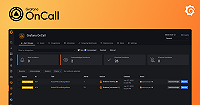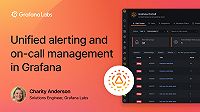Caution
As of 2025-03-11, Grafana OnCall OSS has entered maintenance mode, and will be archived on 2026-03-24. No further feature development will occur; however, we will still provide fixes for critical bugs and for valid CVEs with a CVSS score of 7.0 or higher. For more information, refer to our blog post.
Important: This documentation is about an older version. It's relevant only to the release noted, many of the features and functions have been updated or replaced. Please view the current version.
Create an escalation chain
curl "{{API_URL}}/api/v1/escalation_chains/" \
--request POST \
--header "Authorization: meowmeowmeow" \
--header "Content-Type: application/json" \
--data '{
"name": "example-chain"
}'The above command returns JSON structured in the following way:
{
"id": "FWDL7M6N6I9HE",
"name": "example-chain",
"team_id": null
}HTTP request
POST {{API_URL}}/api/v1/escalation_chains/
Get an escalation chain
curl "{{API_URL}}/api/v1/escalation_chains/F5JU6KJET33FE/" \
--request GET \
--header "Authorization: meowmeowmeow" \
--header "Content-Type: application/json"The above command returns JSON structured in the following way:
{
"id": "F5JU6KJET33FE",
"name": "default",
"team_id": null
}HTTP request
GET {{API_URL}}/api/v1/escalation_chains/<ESCALATION_CHAIN_ID>/
List escalation chains
curl "{{API_URL}}/api/v1/escalation_chains/" \
--request GET \
--header "Authorization: meowmeowmeow" \
--header "Content-Type: application/json"The above command returns JSON structured in the following way:
{
"count": 2,
"next": null,
"previous": null,
"results": [
{
"id": "F5JU6KJET33FE",
"name": "default",
"team_id": null
}
]
}HTTP request
GET {{API_URL}}/api/v1/escalation_chains/
Delete an escalation chain
curl "{{API_URL}}/api/v1/escalation_chains/F5JU6KJET33FE/" \
--request DELETE \
--header "Authorization: meowmeowmeow" \
--header "Content-Type: application/json"HTTP request
DELETE {{API_URL}}/api/v1/escalation_chains/<ESCALATION_CHAIN_ID>/



